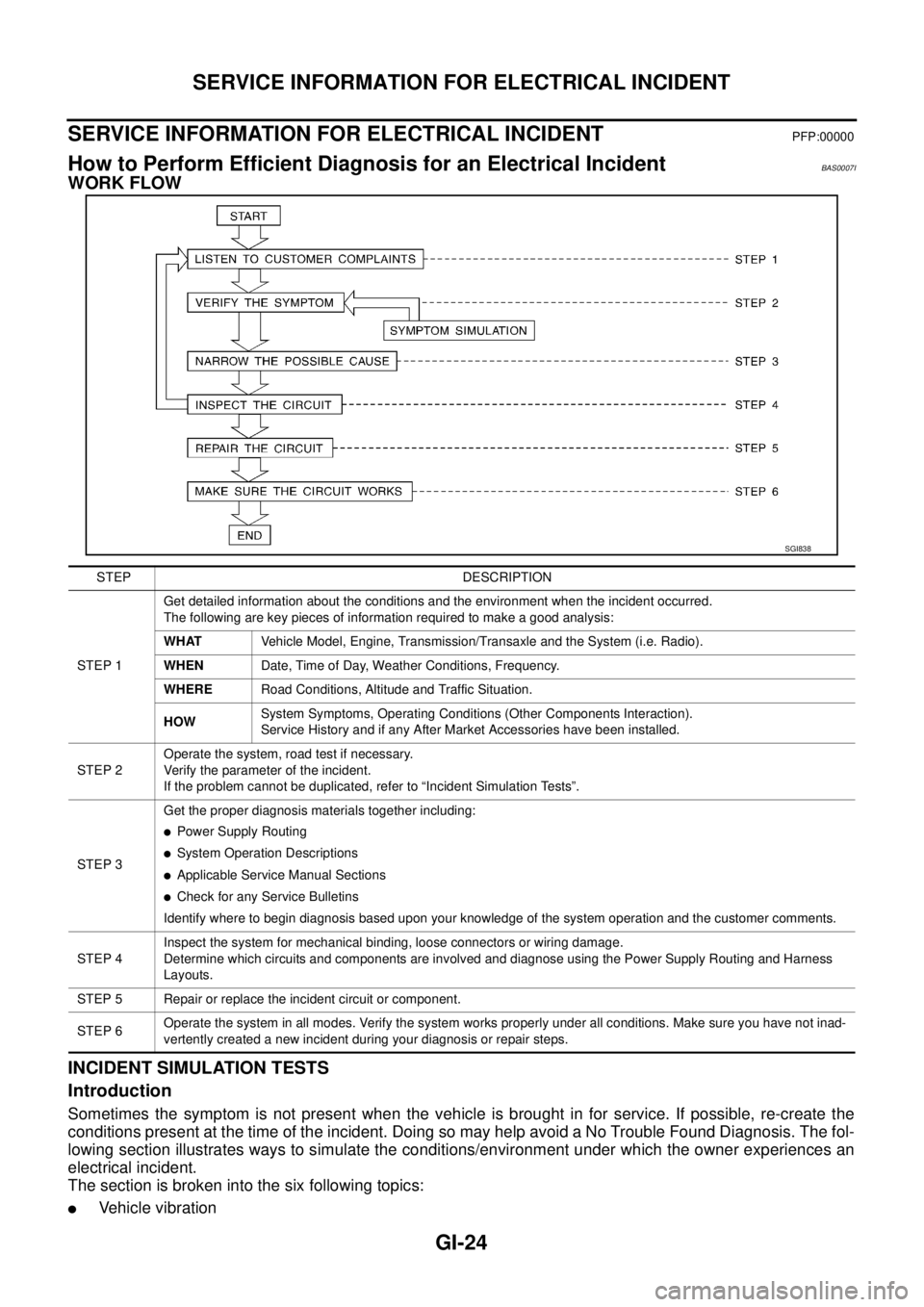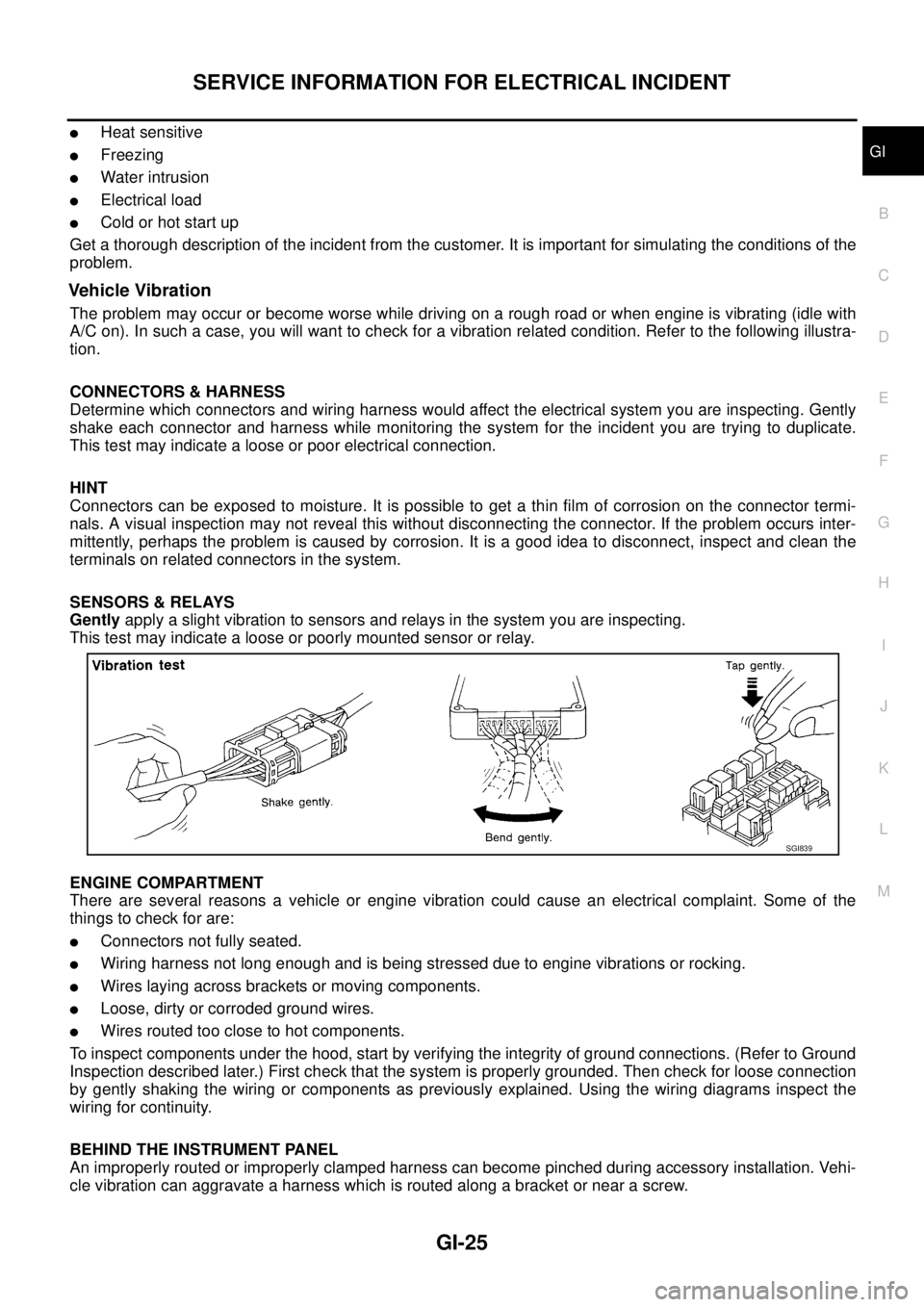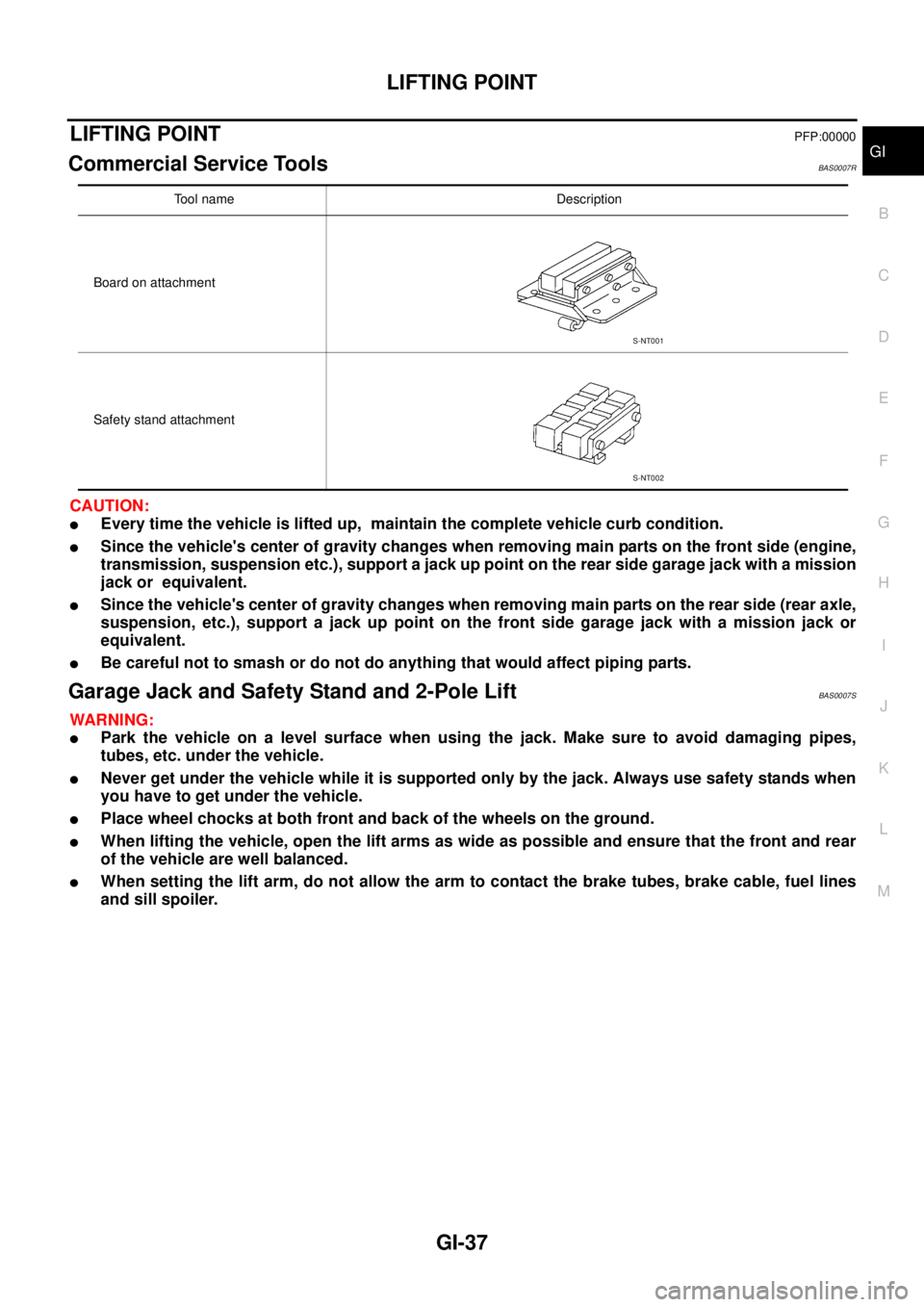Page 2469 of 3502
HOW TO USE THIS MANUAL
GI-23
C
D
E
F
G
H
I
J
K
L
MB
GI
AbbreviationsBAS0007H
The following ABBREVIATIONS are used:
ABBREVIATION DESCRIPTION
A/C Air Conditioner
A/T Automatic Transaxle/Transmission
ATF Automatic Transmission Fluid
D
1Drive range 1st gear
D
2Drive range 2nd gear
D
3Drive range 3rd gear
D
4Drive range 4th gear
FR, RR Front, Rear
LH, RH Left-Hand, Right-Hand
M/T Manual Transaxle/Transmission
OD Overdrive
P/S Power Steering
SAE Society of Automotive Engineers, Inc.
SDS Service Data and Specifications
SST Special Service Tools
2WD 2-Wheel Drive
2
22nd range 2nd gear
2
12nd range 1st gear
1
21st range 2nd gear
1
11st range 1st gear
Page 2470 of 3502

GI-24
SERVICE INFORMATION FOR ELECTRICAL INCIDENT
SERVICE INFORMATION FOR ELECTRICAL INCIDENTPFP:00000
How to Perform Efficient Diagnosis for an Electrical IncidentBAS0007I
WORK FLOW
INCIDENT SIMULATION TESTS
Introduction
Sometimes the symptom is not present when the vehicle is brought in for service. If possible, re-create the
conditions present at the time of the incident. Doing so may help avoid a No Trouble Found Diagnosis. The fol-
lowing section illustrates ways to simulate the conditions/environment under which the owner experiences an
electrical incident.
The section is broken into the six following topics:
�Vehicle vibration
SGI838
STEP DESCRIPTION
STEP 1Get detailed information about the conditions and the environment when the incident occurred.
The following are key pieces of information required to make a good analysis:
WHATVehicle Model, Engine, Transmission/Transaxle and the System (i.e. Radio).
WHENDate, Time of Day, Weather Conditions, Frequency.
WHERERoad Conditions, Altitude and Traffic Situation.
HOWSystem Symptoms, Operating Conditions (Other Components Interaction).
Service History and if any After Market Accessories have been installed.
STEP 2Operate the system, road test if necessary.
Verify the parameter of the incident.
If the problem cannot be duplicated, refer to “Incident Simulation Tests”.
STEP 3Get the proper diagnosis materials together including:
�Power Supply Routing
�System Operation Descriptions
�Applicable Service Manual Sections
�Check for any Service Bulletins
Identify where to begin diagnosis based upon your knowledge of the system operation and the customer comments.
STEP 4Inspect the system for mechanical binding, loose connectors or wiring damage.
Determine which circuits and components are involved and diagnose using the Power Supply Routing and Harness
Layouts.
STEP 5 Repair or replace the incident circuit or component.
STEP 6Operate the system in all modes. Verify the system works properly under all conditions. Make sure you have not inad-
vertently created a new incident during your diagnosis or repair steps.
Page 2471 of 3502

SERVICE INFORMATION FOR ELECTRICAL INCIDENT
GI-25
C
D
E
F
G
H
I
J
K
L
MB
GI
�Heat sensitive
�Freezing
�Water intrusion
�Electrical load
�Cold or hot start up
Get a thorough description of the incident from the customer. It is important for simulating the conditions of the
problem.
Vehicle Vibration
The problem may occur or become worse while driving on a rough road or when engine is vibrating (idle with
A/C on). In such a case, you will want to check for a vibration related condition. Refer to the following illustra-
tion.
CONNECTORS & HARNESS
Determine which connectors and wiring harness would affect the electrical system you are inspecting. Gently
shake each connector and harness while monitoring the system for the incident you are trying to duplicate.
This test may indicate a loose or poor electrical connection.
HINT
Connectors can be exposed to moisture. It is possible to get a thin film of corrosion on the connector termi-
nals. A visual inspection may not reveal this without disconnecting the connector. If the problem occurs inter-
mittently, perhaps the problem is caused by corrosion. It is a good idea to disconnect, inspect and clean the
terminals on related connectors in the system.
SENSORS & RELAYS
Gently apply a slight vibration to sensors and relays in the system you are inspecting.
This test may indicate a loose or poorly mounted sensor or relay.
ENGINE COMPARTMENT
There are several reasons a vehicle or engine vibration could cause an electrical complaint. Some of the
things to check for are:
�Connectors not fully seated.
�Wiring harness not long enough and is being stressed due to engine vibrations or rocking.
�Wires laying across brackets or moving components.
�Loose, dirty or corroded ground wires.
�Wires routed too close to hot components.
To inspect components under the hood, start by verifying the integrity of ground connections. (Refer to Ground
Inspection described later.) First check that the system is properly grounded. Then check for loose connection
by gently shaking the wiring or components as previously explained. Using the wiring diagrams inspect the
wiring for continuity.
BEHIND THE INSTRUMENT PANEL
An improperly routed or improperly clamped harness can become pinched during accessory installation. Vehi-
cle vibration can aggravate a harness which is routed along a bracket or near a screw.
SGI839
Page 2479 of 3502

CONSULT-II CHECKING SYSTEM
GI-33
C
D
E
F
G
H
I
J
K
L
MB
GI
CONSULT-II CHECKING SYSTEMPFP:00000
DescriptionBAS0007K
�CONSULT-II is a hand-held type tester. When it is connected with a diagnostic connector equipped on the
vehicle side, it will communicate with the control unit equipped in the vehicle and then enable various
kinds of diagnostic tests.
�Refer to “CONSULT-II Software Operation Manual” for more information.
Function and System Application BAS0007L
x: Applicable
*1:Nissan Anti-Theft System
Nickel Metal Hydride Battery Replacement BAS0007M
CONSULT-II contains a nickel metal hydride battery. When replacing the battery obey the following:
WARNING:
Replace the nickel metal hydride battery with Genuine CONSULT-II battery only. Use of another bat-
tery may present a risk of fire or explosion. The battery may present a fire or chemical burn hazard if
mistreated. Do not recharge, disassemble or dispose of in fire.
Keep the battery out of reach of children and discard used battery conforming to the local regulations.
Diagnostic test
modeFunction
ENGINE
A/T
TRANSMISSION
AIR BAG
METER A/C AMP
IPDM E/R
BCM
ABS
ABS (Including VDC)
INTELLIGENT KEY
NATS
*1
HEADLAMP LEVELIZER
ADAPTIVE LIGHT
AUTO DRIVE POS.
REARVIEW CAMERA
Work supportThis mode enables a technician to adjust some devices faster
and more accurately by following the indications on CONSULT-
II.xxx- - - x - xx - xxxx
Self-diagnostic
resultsSelf-diagnostic results can be read and erased quickly. xxxxxxxxxx x xxx-
Trouble diagnos-
tic recordCurrent self-diagnostic results and all trouble diagnostic
records previously stored can be read.---x------ - ----
Data monitor Input/Output data in the ECU can be read. x x x - x xxxxx - xxxx
CAN diagnosis
support monitorThe condition of CAN communication line can be indicated. x x x - x xxxxx - - xx-
Active testDiagnostic Test Mode in which CONSULT-II drives some actua-
tors apart from the ECUs and also shifts some parameters in a
specified range.x- - - - xxxxx - xxx-
ECU (ECM/TCM)
part numberECU (ECM/TCM) part number can be read. x x x - - - - x x x - x x x x
ECU discrimi-
nated No.Classification number of a replacement ECU can be read to
prevent an incorrect ECU from being installed.---x------ - ----
Function testThis mode can show results of self-diagnosis of ECU with either
“OK” or “NG”. For engines, more practical tests regarding sen-
sors/switches and/or actuators are available.xxxx---xx- - ----
Control unit ini-
tializationAll registered ignition key IDs in NATS components can be ini-
tialized and new IDs can be registered.---------- x ----
DTC work sup-
portThe operating condition to confirm Diagnosis Trouble Codes
can be selected. -x-------- - ----
CALIB data Characteristic information can be read. - - x - ------ - ----
Configuration - - - - - - - x - - - - x - - -
Page 2480 of 3502

GI-34
CONSULT-II CHECKING SYSTEM
Checking Equipment BAS0007N
When ordering the following equipment, contact your NISSAN/INFINITI distributor.
CAUTION:
�Previous CONSULT-II “I” and “Y” DLC-I and DLC-II cables should NOT be used anymore because
their DDL connector pins can be damaged during cable swapping.
�If CONSULT-II is used with no connection of CONSULT-II CONVERTER, malfunctions might be
detected in self-diagnosis depending on control unit which carry out CAN communication.
�If CONSULT-II CONVERTER is not connected with CONSULT-II, vehicle occur the “FAIL SAFE
MODE” which is “LIGHT UP the HEAD LIGHT” and/or “COOLING FAN ROTATING” when CON-
SULT-II is started.
NOTE:
�The CONSULT-II must be used in conjunction with a program card.
CONSULT-II does not require loading (Initialization) procedure.
�Be sure the CONSULT-II is turned off before installing or removing a program card.
CONSULT-II Start ProcedureBAS0007O
NOTE:
Turning ignition switch off when performing CAN diagnosis could cause CAN memory to be erased.
1. Connect CONSULT-II and CONSULT-II CONVERTER to the
data link connector.
2. If necessary, turn on the ignition switch.
3. Touch “START(NISSAN BASED VHCL)” or System Shortcut key
(ex: ENGINE) on the screen.
Tool nameDescription
NISSAN CONSULT-II
1. CONSULT-II unit (Tester internal soft: Resident
version 3.3.0) and accessories
2. Program card AED06A and AEN06A (For NATS)
3. CONSULT-II CONVERTER
SAIA0362E
PAIA0070E
SAIA0450E
Page 2483 of 3502

LIFTING POINT
GI-37
C
D
E
F
G
H
I
J
K
L
MB
GI
LIFTING POINTPFP:00000
Commercial Service Tools BAS0007R
CAUTION:
�Every time the vehicle is lifted up, maintain the complete vehicle curb condition.
�Since the vehicle's center of gravity changes when removing main parts on the front side (engine,
transmission, suspension etc.), support a jack up point on the rear side garage jack with a mission
jack or equivalent.
�Since the vehicle's center of gravity changes when removing main parts on the rear side (rear axle,
suspension, etc.), support a jack up point on the front side garage jack with a mission jack or
equivalent.
�Be careful not to smash or do not do anything that would affect piping parts.
Garage Jack and Safety Stand and 2-Pole LiftBAS0007S
WARNING:
�Park the vehicle on a level surface when using the jack. Make sure to avoid damaging pipes,
tubes, etc. under the vehicle.
�Never get under the vehicle while it is supported only by the jack. Always use safety stands when
you have to get under the vehicle.
�Place wheel chocks at both front and back of the wheels on the ground.
�When lifting the vehicle, open the lift arms as wide as possible and ensure that the front and rear
of the vehicle are well balanced.
�When setting the lift arm, do not allow the arm to contact the brake tubes, brake cable, fuel lines
and sill spoiler.
Tool name Description
Board on attachment
Safety stand attachment
S-NT001
S-NT002
Page 2487 of 3502
IDENTIFICATION INFORMATION
GI-41
C
D
E
F
G
H
I
J
K
L
MB
GI
IDENTIFICATION INFORMATIONPFP:00010
Model Variation BAS0007Y
Prefix and suffix designations:
IDENTIFICATION NUMBER
Destination Body Engine Transaxle Grade Model
Russia/Ukraine SedanQR20DE
4ATL2 BDAULEA-EQA
VQ23DEL3 BLNULGA-EQA
L4BLNULHA-EQA
VQ35DE CVT BLJULHW-EQA
SAIA1353E
SAIA0637E
Page 2488 of 3502
GI-42
IDENTIFICATION INFORMATION
Vehicle Identification Number Arrangement
IDENTIFICATION PLATE
ENGINE SERIAL NUMBER
VQ Engine
SAIA1354E
SAIA0587E
SAIA0361E